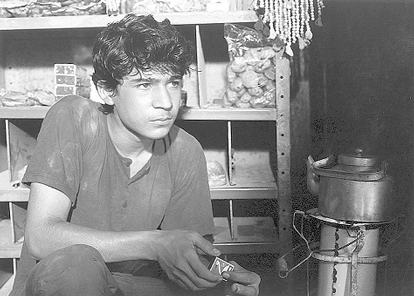Dry-docked on “Iron Island” with an Iranian Captain Nemo
An oil tanker in the Persian Gulf is a crucible for life in the stunning Iranian film, “Iron Island.” Written, directed, and produced by Mohammad Rasoulof, the film eschews a conventional narrative by introducing an interesting cast of characters and letting the complex relationships between them unfold slowly.
Captain Nemat (Ali Nasirian) is the figurehead of the ship, keeping accounts of people’s rent, phone charges, and other miscellaneous expenses. The members of the community certainly are resourceful. Through a barter system, homeless families eke out their existence in makeshift rooms and through work making burkahs, delivering oil, and selling the iron on the ship as scrap. What is more, the kids go to a school on board, and in one scene, the teacher is shown making chalk using rifle casings.
Things are operating pretty nicely until the captain gets the news that the ship is sinking and he is asked to evacuate his people. Viewers can draw their own conclusions regarding any parallels to the crisis in Iran past or present.
Nemat’s response in the face of this news is to dismiss the problem outright, claiming that the ship is still useful. He soon, however, acknowledges that he must relocate his community of people. Other individual stories have already emerged that show how much Nemat’s authority has been challenged or subverted.
The most interesting subplot involves Nemat’s right hand man, Ahmad (Hossein Farzi-Zadeh), a young boy, who is in love with a girl on the ship (Neda Pakdaman) Nemat is selling into marriage to someone else. In one of the more moving scenes, Ahmad engages in personal exchanges with the girl privately, silently, and discreetly late at night. However, on the girl’s wedding day, when Ahmad defies Nemat’s wishes, he is punished by near drowning in an unforgettable sequence. Rasoulof ratchets up the tension as this storyline comes to a head, showing just how authoritative Nemat can be when he is angry.
In contrast, two other characters provide interesting, alternate storylines. Baby Fish is a young boy who captures fish that swim into the tanker, and he later releases them back into the ocean. His routine is disrupted when the ship has to be evacuated. Uncle Sadegh is an old man who continuously stares out at the sun “looking for something” that only he will recognize. Although these characters obviously represent the old fashioned way of life, and the future, it is to the filmmaker’s credit that they never feel like heavy-handed symbols.
“Iron Island” benefits from extraordinary cinematography. The look of the film—which opens in candlelight, but expands to beautiful vistas of the gulf—contains some unusual imagery. The wedding sequence in which the girl has henna applied to her hands is intimate, and the “drowning” episode in which Ahmad is repeatedly dunked in the water are fantastic. Rasoulof also does a magnificent job of keeping the action almost entirely aboard the tanker without ever making it seem claustrophobic.
If the film fails to explain how these people came to live on the tanker, and for how long, it does not have to. As an allegory, audiences are able to form their own backstories for the characters, all of whom are fully fleshed out here. The performances by Nasirian and Farzi-Zadeh are incredibly real, both actors experts at providing facial expressions to convey what their characters are thinking at all times, The film’s interesting musical score also adds to creating the sense of time and place of the characters.
“Iron Island” is an unusual Iranian film. It also may be one of the few that uses the F-word several times. But despite its episodic structure and overall lack of plotting, it is a compelling and worthwhile viewing.
gaycitynews.com



































